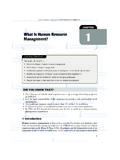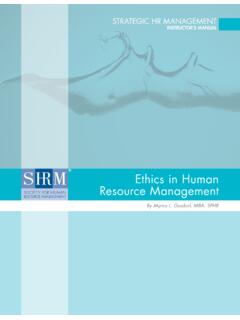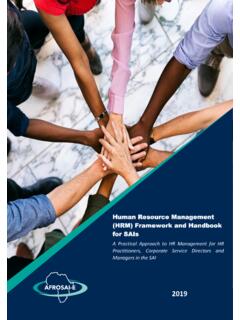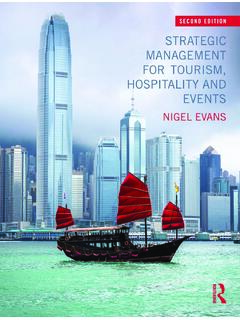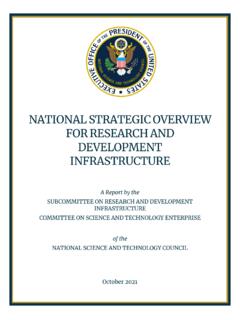Transcription of Chapter 1 HUMAN RESOURCE MANAGEMENT, THEORY …
1 DCCH AUSTRALIA LIMITEDDate: 24-APR-14 Time: 16:30 Seq: 11 Chapter 1 HUMAN RESOURCE MANAGEMENT, THEORY AND PRACTICEKey issues HUMAN RESOURCE management deals with the effective and efficientmanagement of an organisation s employees. All HUMAN RESOURCE management functions must link to each other and tothe organisation s goals and strategies. HUMAN RESOURCE planning aims to ensure that organisational objectives areachieved by getting the right quantity, quality and skills mix of employees atthe right time. Recruitment programs are affected by internal and external factors such aseconomic conditions and the nature of the organisation. Labour demand forecasting is an important part of HUMAN resourceplanning. 1-100 What is strategic HUMAN resourcemanagement?Recruitment and selection within an organisation is an integral part of thatorganisation s overall HUMAN RESOURCE management and planning process.
2 Assuch, it is related closely to other HUMAN RESOURCE management processes, forinstance, job design, HUMAN RESOURCE development, performance appraisaland management , reward systems, career and succession planning,promotions and key concepts underlie modern HUMAN RESOURCE management (HRM)practice and are reflected in all activities concerned with the attraction,maintenance and separation of an organisation s employees. They are:(1) employees as HUMAN resources, HUMAN capital or organisational assets,and(2) HUMAN RESOURCE management as a long-term, integrative and accountablestrategic first concept highlights the productive contribution of employees, bothactual and potential, while the second focuses on the approach of humanresource management practitioners to optimise this contribution fororganisational benefit. Where are these concepts more crucial than in thecareful and cost-effective attraction and choice of employees duringrecruitment and selection?
3 1-100 Oxford University Press Sample ChapterDCCH AUSTRALIA LIMITEDDate: 24-APR-14 Time: 16:30 Seq: 22 Effective Recruitment and Selection PracticesSocial, economic, political and workplace relations changes, together withdevelopments in the HUMAN RESOURCE (HR) profession, have propelledpractitioners towards innovative managerial perspectives, approaches andstrategies. New skills, especially in the information technology/telecommunications and accounting areas, need to be acquired, applied andevaluated. Economic fluctuations, legislative developments in areas such asworkplace relations, equal employment opportunity, privacy and workplacehealth and safety, environmental and quality of work life issues providehuman RESOURCE practitioners with both pressures and on recruitment strategies and selection techniques are balanced byopportunities to grow current employees in innovative and RESOURCE management as a profession is concerned with the effectiveand efficient management of an organisation s employees ( HUMAN resources)towards the achievement of desirable objectives and goals.
4 It has displacedearlier models (eg personnel administration, personnel management ) becauseof its emphasis on the integration of all traditional personnel functions (eg jobdesign, recruitment and selection, HUMAN RESOURCE development, rewardssystems, career management , etc) and their management towardsorganisational strategic outcomes and RESOURCE management involves a perception that employees arehuman resources (or even HUMAN capital), not unlike other organisationalresources such as finance and technology, who need to be managed in similar(and different) ways in order to achieve productivity and profitabilityoutcomes. Specific HUMAN RESOURCE management functions then provide themeans by which employees are acquired (eg HUMAN RESOURCE planning, jobdesign, recruitment and selection), developed (eg HUMAN RESOURCE development,reward and remuneration systems, performance and career management ) andultimately terminated (eg dismissal, retirement and redundancy programs)according to organisational requirements.
5 It thus involves a HUMAN resourcemanagement strategy and a HUMAN RESOURCE management plan, consistentwith overall organisational strategies, which subsequently feed into each ofthe related HUMAN RESOURCE functions. 1-100 Oxford University Press Sample ChapterDCCH AUSTRALIA LIMITEDDate: 24-APR-14 Time: 16:30 Seq: 33 HUMAN RESOURCE management , THEORY and practiceDiagram : Recruitment as a strategic HRM toolSource: Nankervis, A, Compton, R, Baird, M, Coffey, J, 2011, HUMAN resourcemanagement: strategies and processes, 7th edn, Cengage, Melbourne, p illustrates the ideal relationships between organisational andhuman RESOURCE management strategies, plans and functions, and highlightsthe centrality of recruitment and selection in the overall HUMAN resourcemanagement important concepts in strategic HUMAN RESOURCE management are those ofhorizontal and vertical alignment.
6 Horizontal alignment refers to the need forhuman RESOURCE professionals to ensure that all HUMAN RESOURCE managementfunctions (eg job design, recruitment and selection, HUMAN resourcedevelopment, performance management , remuneration, retrenchment, etc) areclearly linked to each other and to the organisation s goals. As an example, anorganisation intending to expand overseas would need to ensure that: it could attract skilled and experienced technical and managerial stafffrom Australia or in international markets it was using the most suitable recruitment and selection techniques, and its remuneration and career development/retention programs matchedits advertised the other hand, its HUMAN RESOURCE professionals would need to ensurethat all these functions reflected the organisation s culture, budgets andlonger-term strategies. Culture, budgets and strategies are among the requiredaspects to be considered to achieve vertical alignment with an organisation sgoals and plans.
7 Two other concepts, of internal and external fit , are also ofimportance here. Internal fit suggests that all HUMAN RESOURCE managementfunctions should be designed according to an organisation s internal culture;whilst external fit refers to the need for all organisations to tailor their HR 1-100 Oxford University Press Sample ChapterDCCH AUSTRALIA LIMITEDDate: 24-APR-14 Time: 16:30 Seq: 44 Effective Recruitment and Selection Practicesprograms to the demands of their (external) industry, national and regionalcontexts ( dynamic environments in Diagram ).While practical evidence on the role of HR professionals as strategic businesspartners , demonstrating both horizontal and vertical alignment, internal andexternal fit, is limited, there are some promising indications of its studies (Guest, D, 2011, HRM and performance: still searching forsome answers , HRM journal, 21(1), pp 1 13; Butler, P, McEvoy, G, 2012, strategic HUMAN RESOURCE management and performance: sharpening line ofsight , HRM review, 22, pp 43 56) reveal significant contributions of humanresource management systems to organisational performance, with the latterauthors concluding that much of the recent research suggests that HRMpractices can positively affect firm performance, primarily through theirimpacts on HUMAN and social capital.
8 The HRM objectives are to establishand promote a clear alignment of capabilities at all levels with the firm sstrategic goals and to create the culture, norms, motivation and opportunity toengage in actions that contribute to these goals (p 54).Diagram below shows the HR professional capabilities (competencies)considered by the Australian HUMAN Resources Institute (AHRI) as essentialcomponents of a business-driven approach to the HUMAN RESOURCE : AHRI model of excellence Driving your successSource: HR Competency Model (Ulrich & Brockbank 2007) and AHRI HR ManagementModel RESOURCE management is comprised of a number of interrelatedactivities that combine to drive business performance. With a base capabilityof being business driven, HR professionals require the following additional 1-100 Oxford University Press Sample ChapterDCCH AUSTRALIA LIMITEDDate: 24-APR-14 Time: 16:30 Seq: 55 HUMAN RESOURCE management , THEORY and practicecapabilities: strategic architect, stakeholder manager, workforce designer,credible activist, expert practitioner, and culture and change agent.
9 Humanresource management knowledge and capability underpin HR practice andinfluence the professional behaviour of HR professionals and how they areperceived. In addition, the overarching goal of people leading business isunderpinned by the following four HR objectives: contribute to a profitable and sustainable organisation increase workforce competency and engagement develop excellence in people management create a dynamic and productive work of these capabilities may be displayed in the specific recruitment andselection functions of HUMAN RESOURCE management , but perhaps the mostimportant capabilities for HR practitioners are those of workforce designer,stakeholder manager, expert practitioner, culture and change agent. Thus, asworkforce designers, practitioners will be engaged in decisions about thestructure, clusters, and tasks involved in particular jobs; as stakeholdermanagers, they manage the expectations of managers, work groups andpotential new employees; as expert practitioners, they must demonstrate theircompetence in the design of effective recruitment and selection processes; andas culture and change agents, use these processes to ensure that newemployees fit into their jobs and work a HUMAN RESOURCE management perspective, recruitment and selectionreflect broader staffing strategies, and represent the first stage of themanagement of HUMAN resources (employees) towards organisational can be considered as the most difficult and yet the most crucial of allhuman RESOURCE management strategies.
10 Acquiring the best applicants can bea huge bonus to organisations, but hiring less than the best can result inenormous disruption, reduced productivity, interpersonal difficulties andinterruptions to teamwork, customer service problems, and long-term both stakeholder managers and expert practitioners, HR professionals areusually the key organisational informants, interpreters, and advisers withrespect to the workplace impacts of existing and new federal and stategovernment legislation, especially in industrial relations,diversity/discrimination, workplace health and safety, equal employment andprivacy. Perhaps the most important contemporary pieces of legislationrequiring advice from HR professionals in Australia are the Fair Work Act2009, established under the Rudd-Gillard Labor federal government, and thecurrent amendments proposed by the Fair Work Amendment Act 2013 underthe Abbott Liberal government.



